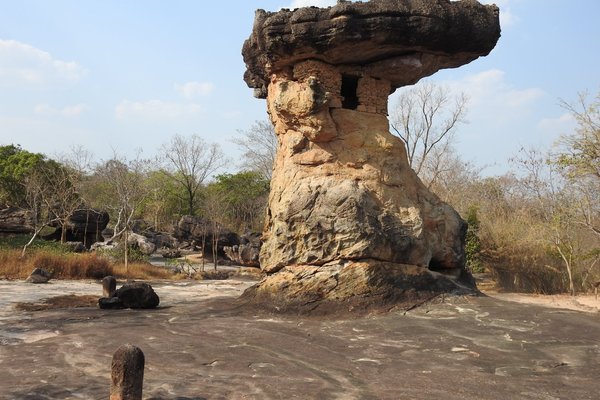Thailand
Phu Phrabat
Phu Phrabat, a testimony to the Sīma stone tradition of the Dvaravati period, comprises a wooded sandstone hill containing huge bare rocks in spectacular overhanging positions.
Since prehistoric times, the landscape has been a place of sanctity for the local inhabitants. The park contains rock paintings from the prehistoric period and religious icons from successive cultural periods, including two symbolic footprints of Lord Buddha.
Community Perspective: This is an easy and popular site from Udon Thani, given that it already had 5 reviews and 23 visitors before inscription. Stanislaw has explained how to reach it by public transport.
Site Info
Official Information
- Full Name
- Phu Phrabat, a testimony to the Sīma stone tradition of the Dvaravati period (ID: 1507)
- Country
- Thailand
- Status
-
Inscribed 2024
Site history
History of Phu Phrabat
- 2024: Name change
- Upon inscription, from "Phu Phrabat Historical Park" to "Phu Phrabat, a testimony to the Sīma stone tradition of the Dvaravati period "
- 2024: Inscribed
- Inscribed
- 2016: Requested by State Party to not be examined
- After Referral advice by ICOMOS, dossier needs more info
- 2016: Requested by State Party to not be examined
- After Deferral advice by ICOMOS, Thailand wants to refocus on less criteria
- Type
- Cultural
- Criteria
- iii
- v
Links
- UNESCO
- whc.unesco.org
All Links
UNESCO.org
- whc.unesco.org — whc.unesco.org/
Community Information
- Community Category
- Cultural Landscape: Associative
Travel Information
Recent Connections
-
Stone Quarries
"Than Phra Sung is a rock pillar withou… -
Rock Cut Architecture
"Wat Look Koei (the son-in-law's temple… -
Hand Paintings or Hand Prints
"rock shelters depicting human figures,…
Connections of Phu Phrabat
- History
-
-
Megalithism
megalithic rock shelters
-
- Architecture
-
-
Rock Cut Architecture
"Wat Look Koei (the son-in-law's temple) is a rock shelter modified to create a monastery. (...) The back wall and the lower portions of the two side walls were carved from the rock pillar that supports the top rock." - "Tam Phra (the monk's cave) was a large rock shelter, but the top rock slab collapsed and broke into several pieces sometime in the past. Its bottom part was carved into a large room, with many Buddhist statues sculpted out of the rock pillar." (AB Ev)
-
- World Heritage Process
-
-
Need for a Comparative Study
its first attempt ICOMOS gave deferral for more in-depth comparative study on Sima Stone and other Standing rock culture
-
- Religion and Belief
-
-
Sima Stones
PPB is the corpus of Dvaravati Sima -
Sacred Mountains
as the Thai name implies, it is sacred for locals as the place where Holy Footprints of Lord Buddha are located -
Theravada Buddhism
Wat Look Koei Temple -
Legends and Folk Myths
Usa & Baros Buddhist MythSee en.wikipedia.org
-
- Human Activity
-
-
Stone Quarries
"Than Phra Sung is a rock pillar without a top block of rock. It is a quarry site for the Sima stones of the nearby sacred areas, such as Tam Phra." (AB Ev) -
Pictographs
as seen in many rock shelters -
Hand Paintings or Hand Prints
"rock shelters depicting human figures, hand palms, animals, and geometric patterns" (AB ev) -
Petrosomatoglyphs
"It was believed that Buddha once visited the region and left several footprints on the mountain" (AB ev)
-
- Constructions
-
-
Protective Shelters
"Shelters have been constructed over the Sīma stones at Wat Phra Phuthabat Buaban to protect them from natural erosion since these stones have delicate carvings of Buddha’s life and the Jataka stories." (AB ev)
-
- Timeline
-
-
Built in the 7th century
"During the Dvaravati period (7th–11th centuries CE), when Buddhism spread from central and east Thailand to 133 Northeast Thailand, stones were used by the local people for demarcating sacred areas." (AB ev)
-
- Visiting conditions
-
-
Foreigner prices
Thai 20 THB, Other 100 THB as of 2024
-
- WHS Names
-
-
Name changes
Upon inscription, from "Phu Phrabat Historical Park" to "Phu Phrabat, a testimony to the Sīma stone tradition of the Dvaravati period " -
Named after a Mountain
PPB is located on Phu Phrabat Mountain which means Holy Footprints of Lord Buddha Mountain
-
News
No news.
Recent Visitors
Visitors of Phu Phrabat
- AC
- Alejandro Lau
- Alex Goh
- Bernard Joseph Esposo Guerrero
- Christravelblog
- Dagmara
- Dimitar Krastev
- Els Slots
- Errol Neo
- Fan Yibo
- Francky D'Hoop
- Frederik Dawson
- Ivan Rucek
- Jana and Matt
- Joel on the Road
- Joyce van Soest
- Kerékgyártó
- Luis Filipe Gaspar
- Martina Rúčková
- Mikko
- pete_simms
- Randi Thomsen
- Sergio Arjona
- Shandos Cleaver
- Solivagant
- Stanislaw Warwas
- Svein Elias
- SymonMajewski
- Taotao Chen
- Thomas Buechler
- Thomas van der Walt
- Vincent Cheung
- Zach
- Zoë Sheng
- Zos M
Community Reviews
Show full reviews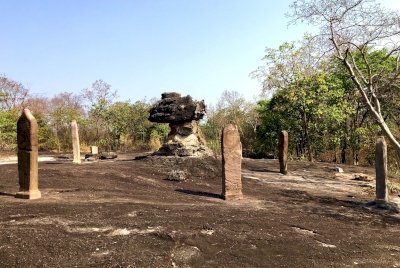
Visited February 2023.
Many things already said here about the site, so I am just sharing some practical info.
How to get there using public transportation? The best place to start is Udon Thani. Renting a car or a car with a driver is one of the solution, but if you do not want to spend a lot of money, go to Rangsina Market (there’s no transport to here from any of two bus stations in Ubon Thani!!!) in the morning, the first sorng-taa-ou (50 THB) leaves at 6:30, and the second at 8:30; it takes around one hour and a half to get to Ban Tew (depending of how many stops would be on the road). Show the driver the picture of the site or the name written in Thai and he’ll drop you in the village at the small junction (close to the small police station) where the road west leads to the Phu Phrabat Historical Park. It is still circa 5 km to the entrance to the park or 4 km to Buddhist Wat Phra Bua Bok, temple that was also mentioned in the nomination from 2016. You can walk, you can hitch-hike or you can ask at the small shop at the corner to take you there for a small money. I started walking to the park and after 3 minutes some man stopped and gave me a lift for free (he did not want any money).
At the site. There’s a small …
Keep reading 0 comments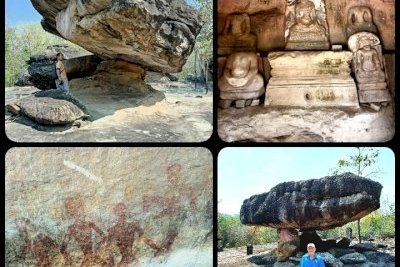
Phu Phra Bat (PPB) is an exemplary multi-layered cultural landscape set on a plateau rising up to 150 meters above the floor plain, and would make a great addition to the World Heritage list. What looks like well-formed dolmens at first sight are in fact magnificent works of nature through weathering. While it is in Udon Thani ---and together with Ban Chiang they form a good argument for the claim that the province sheltered the earliest civilization in Thailand--- we figured that it was easier to visit PPB from Nong Khai. Our accommodation, the Rim Riverside Guesthouse, offered to take us there for 1,000Bt, which was a very good deal. The owner, an avid cyclist, even said it is possible to get to PPB on a bike and that he had already done it a couple of times. What surprised me was the extent of the site and the number of interesting rock formations in place. I recall wanting to go here in 2013 and when I searched the internet, one practically only sees images of the iconic rock tower Hor Nang U-Sa and very little of everything else. Even the latest editions of some guidebooks do not even "highlight" it, perhaps due to its remoteness. So, my friend and I felt we saw more than what we expected.
Despite the instruction of the ticket man not to visit Wat Louk Koei (largest chambered rock temple in the park with well-preserved statues), we still took the 500m trek to …
Keep reading 0 comments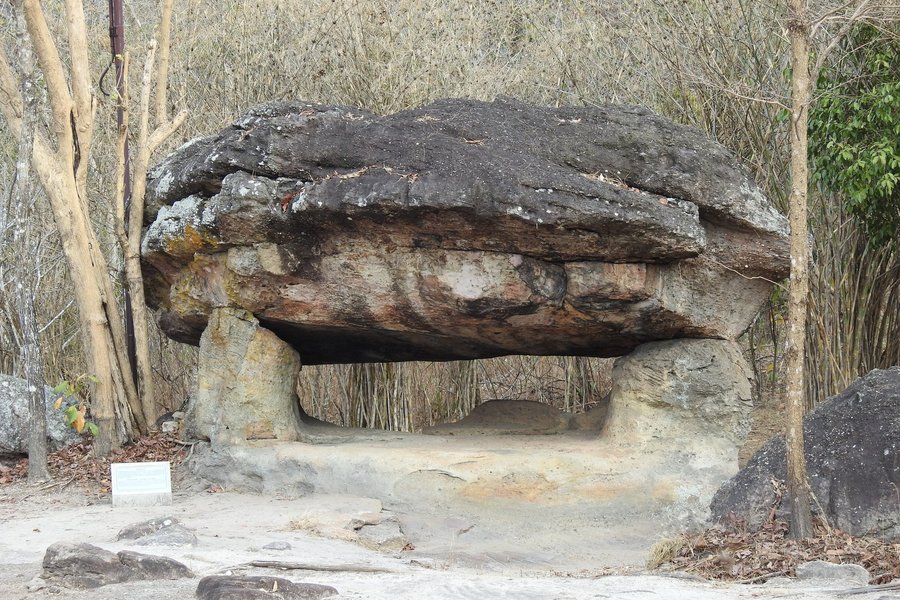
We visited Phuphrabat on a day trip from Udon Thani using a driver sourced via our hotel. It can comfortably be visited in a single day trip along with nearby Ban Chiang (though they are in opposite directions from UT).
Frederick Dawson below has given a good description of the site, where you climb slowly through a forest onto a sandstone plateau to find a group of tall rocks balanced in improbable locations. Geologically, they aren't glacial as one might expect - instead sandstone of varying densities that has eroded at varying rates.
The rock overhangs and shelters created were home to various different tribes and groups over the centuries, and there's still traces of ancient occupation including rock art. Although nowhere near as impressive as other rock art we've seen in semi-nearby places like Bhimbetka (India) and Kakadu (Australia), it's still quite well preserved in places and you can see human and animal figures quite clearly.
The Buddha statues are mostly broken, and I think generally date to a later period of occupation so perhaps a little less signficant.
Overall it's not the greatest site we've seen (and not the greatest in Thailand), but I still think it's worth adding as there are precious few sites of this kind in South-East Asia.
As a side-note, the bathrooms here are absolutely outstanding! For whatever reason, this tiny little unvisited spot in the middle of nowhere in Thailand has two freestanding toilet blocks, fitted out on …
Keep reading 0 comments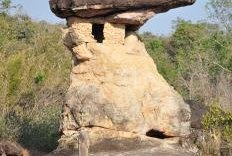
Thailand is planning to propose Phu Phrabat as a World Heritage Site in 2016, the news really made me want to write the review of this strange historical park in the Northeastern part of this country near the city of Udonthani. My trip to Phu Phrabat, the place actually sounds like Poo – Pa – Baht, had happened because I saw its picture when I visited Ban Chiang. The hotel arranged a car with driver for me to visit the place in the next morning. When I arrived in Phu Phrabat Historical Park, I was surprised that the place was really quiet and no tourist at all. My driver and I walked into the forest, which is a typical sight in this region, after 15 minutes, I started to see the strange, shaped rock formation behind the trees.
The biggest and most stunning rock called U-Sa Tower. The rock shape looks like a big unfinished Winged Victory of Samothrace in my opinion, but for my driver a big mushroom. Ancient people also made a small room attached to the rock which made the rock more unique, similar to US’s Mesa Verde. In front of U-Sa Tower also have ancient standing stones, sima, which historians believed to be the symbol of sacred precinct for ancient ceremony. Then I continued my sightseeing to see more bizarre rocks that named as coffins of ancient royalties. I also saw ancient Buddhist rock cravings and rock arts which actually in my opinion not …
Keep reading 0 comments
I understand that there are two parts to this nomination. I however only visited the main part where all the strange rock formations are located.
This is an interesting site and it is still possible to find evidence of how the unusual rock formations with huge boulders balancing on often smaller ones were used for religious purposes. These rocks take their shapes apparently because of under-sea erosion that happened millions of years ago. Traces of prehistoric rock art can also be found on some of the rocks and a number of these paintings were hardly visible. It is almost necessary (unless one has done quite a bit of research and has a very sharp eye) to have a guide to point them out for the ordinary visitor. Someone had to actually point one such painting out with a long stick to me before I could see it. The kind man who pointed it out to me told me that it was an elephant but I had to stare at it for quite some time before I could even see that it sort of resembled an elephant.
The historical park is located entirely within a forest park although being in the "drier" (dryness in this case being a relative concept) part of Thailand it is not quite wild tropical Asia. It was nevertheless still a rather wild place and a snake basking on one of the rocks scared the living daylights out of my guide. I found the place rather enjoyable …
Keep reading 0 comments
